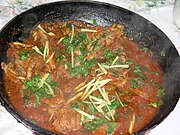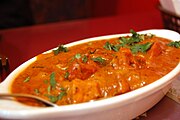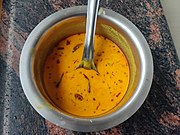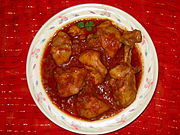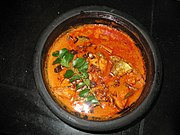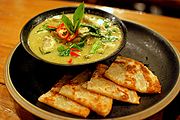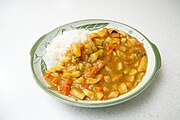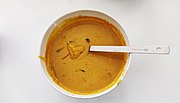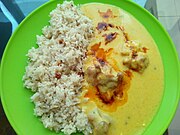Curry
 Indian curries | |
| Place of origin | Indian subcontinent |
|---|---|
| Region or state | Worldwide |
| Main ingredients | Meat or vegetables, oil orghee,spices |
Curryis a dish with a sauce seasoned with spices, mainly associated withSouth Asian cuisine.[1][2]It is not to be confused with leaves from thecurry tree,though some curries do include curry leaves.[3][4][5]Curry is also found in the native cuisines of many South East Asian and East Asian countries due to ancient contact with South Asia.[6]
There are many varieties of curry. The choice of spices for each dish in traditional cuisine depends on regional cultural traditions and personal preferences. Such dishes have names that refer to their ingredients, spicing, and cooking methods.[7]Outside the Indian subcontinent, a curry is a dish from Southeast Asia which usescoconut milkor spice pastes and is commonly eaten over rice.[6]Curries may contain fish, meat, poultry, or shellfish, either alone or in combination with vegetables. Others are vegetarian. Dry curries are cooked using small amounts of liquid, which is allowed to evaporate, leaving the other ingredients coated with the spice mixture. Wet curries contain significant amounts of sauce or gravy based onbroth,coconut creamorcoconut milk,dairycreamoryogurt,orlegumepurée,sautéedcrushed onion, ortomato purée.
Curry powder,a commercially prepared mixture of spices marketed in the West, was first exported to Britain in the 18th century when Indian merchants sold aconcoctionof spices, similar togaram masala,to the British East India Company returning to Britain.
Etymology[edit]

Curry is ananglicisedform of theTamilகறிkaṟimeaning 'sauce' or 'relish for rice' that uses the leaves of thecurry tree(Murraya koenigii).[8][self-published source?][9][10][11]The wordkariis also used in otherDravidian languages,namely inMalayalam,KannadaandKodavawith the meaning of "vegetables (or meat) of any kind (raw or boiled), curry".[12]Kaṟiis described in a mid-17th centuryPortuguesecookbook by members of the BritishEast India Company,[13]who were trading with Tamil merchants along theCoromandel Coastof southeast India,[14]becoming known as a "spice blend... calledkari podior curry powder ".[14]The first appearance in its anglicised form (spelledcurrey) was inHannah Glasse's 1747 bookThe Art of Cookery Made Plain and Easy.[9][13]
The wordcuryin the 1390s English cookbook,The Forme of Cury,[13]is unrelated, coming from the Middle French wordcuire,meaning 'to cook'.[15]
History[edit]
Evidence has been found that Austronesian merchants in South East Asia traded spices along marine trade routes between South Asia (primarily the ports on the south eastern coast of India and Sri Lanka) and East Asia as far back at 5000 BCE.[16][17][18]Archaeological evidence dating to 2600 BCE fromMohenjo-daroalso suggests the use ofmortar and pestleto pound spices includingmustard,fennel,cumin,andtamarindpods with which they flavoured food.[19]Black pepperis native to theIndian subcontinentand Southeast Asia and has been known toIndian cookingsince at least 2000 BCE.[20]
The three basic ingredients of the spicy stew wereginger,garlic,andturmeric.Using a method called "starch grain analysis", archaeologists identified the residue of these spices in both skeletons and pottery shards from excavations in India, finding that turmeric and ginger were present.[21][22]
The establishment of theMughal Empire,in the early 16th century, also influenced some curries, especially in the north. Another influence was the establishment of the Portuguese trading centre inGoain 1510, resulting in the introduction ofchili pepper,tomatoes and potatoes to India from the Americas, as a byproduct of theColumbian Exchange.[23]
The British lumped all sauce-based dishes under the generic name 'curry'.[7][24]It was introduced toEnglish cuisinefromAnglo-Indian cookingin the 17th century, as spicy sauces were added to plain boiled and cooked meats.[25]Curry was first served in coffee houses in Britain from 1809, and has been increasingly popular in Great Britain, with major jumps in the 1940s and the 1970s.[26]During the 19th century, curry was carried to the Caribbean by Indianindenturedworkers in the Britishsugar industry.Since the mid-20th century, curries of many national styles have become popular far from their origins, and increasingly become part of internationalfusion cuisine.[27]
By region[edit]
South Asia[edit]


India is the home of curry, and manyIndian dishesare curry-based, prepared by adding different types of vegetables, lentils, or meats. The content of the curry and style of preparation vary by region. Most curries are water-based, with occasional use of dairy and coconut milk. Curry dishes are usually thick and spicy and are eaten along with steamed rice and a variety of Indian breads. The popularrogan josh,for example, fromKashmiri cuisine,is a wet curry of lamb with a red gravy coloured by Kashmiri chillies and an extract of the red flowers of thecockscomb plant(mawal).[28]Goshtaba(large lamb meatballs cooked in yoghurt gravy) is another curry dish from theWazwantradition occasionally found in Western restaurants.[29]
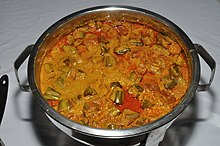
Curries inBengali cuisineinclude seafood and fresh fish. Mustard seeds and mustard oil are added to many recipes, as are poppy seeds.Emigrantsfrom theSylhet districtof Bangladesh founded the curry house industry in Britain, while inSylhetsome restaurants run by expatriates specialise in British-style Indian food.[30]
Rice and curry is the staple dish of Sri Lanka.[31]
East Asia[edit]
Curry spread to other regions of Asia. Although not an integral part ofChinese cuisine,curry powder is added to some dishes in the southern part of China. The curry powder sold in Chinese grocery stores is similar to Madras curry powder but with addition ofstar aniseand cinnamon.[32]The former Portuguese colony of Macau has itsown culinary traditionsand curry dishes, includingGalinha à portuguesaand curry crab.Portuguese sauceis a sauce flavoured with curry and thickened withcoconut milk.[33]

Japanese curryis usually eaten askarē raisu– curry, rice, and often pickled vegetables, served on the same plate and eaten with a spoon, a common lunchtime canteen dish. It is less spicy and seasoned than Indian and Southeast Asian curries, being more of a thick stew than a curry. British people brought curry from theIndian colonyback to Britain[34]and introduced it to Japan during theMeiji period(1868 to 1912), after Japan ended its policy of national self-isolation (sakoku), and curry in Japan was categorised as aWestern dish.[35]Its spread across the country is attributed to its use in theJapanese ArmyandNavywhich adopted it extensively as convenient field and naval canteen cooking, allowing even conscripts from the remotest countryside to experience the dish. TheJapan Maritime Self-Defense Forcetraditionally have curry every Friday for lunch and many ships have their own recipes.[36]The standard Japanese curry contains onions, carrots, potatoes, and sometimescelery,and a meat that is cooked in a large pot. Sometimes grated apples orhoneyare added for additional sweetness and other vegetables are sometimes used instead.[37]
Curry was popularized inKorean cuisinewhenOttogientered the Korean food industry with a curry powder in 1969.[38][39]Korean curry, usually served with rice, is characterized by the golden yellow colour of turmeric. Currytteokbokkiis made oftteok(rice cakes),eomuk(fish cakes), eggs, vegetables, and curry. Curry can be added to Korean dishes such asbokkeumbap(fried rice),sundubujjigae(silken tofu stew), fried chicken, vegetable stir-fries, and salads.
Southeast Asia[edit]

Indian Indonesian cuisineconsists of adaptations of authentic dishes fromIndia,as well as original creations inspired by the diverse food culture ofIndonesia.Curry inIndonesianiskariand inJavaneseiskare.InIndonesian cuisineespecially inBandung,there is a dish calledlontong kari,a combined oflontongand beef yellow curry soup.[40]InJavanese cuisine,kare rajungan,blue swimmer crabcurry has become a delicacy ofTuban Regency,East Java.[41]Rendang,the national dish of Indonesia, which is originated fromMinang,is drier and contains mostly meat and more coconut milk than a conventional Malaysian curry; it was mentioned in Malay literature in the 1550s byHikayat Amir Hamzah.[42]
Malaysian cuisinemay have initially incorporated curries via the Indian population, but it has become a staple among the Malay and Chinese populations there. Malaysian curries typically use turmeric-rich curry powders, coconut milk, shallots, ginger,belacan(shrimp paste), chili peppers, and garlic.Tamarindis also often used.
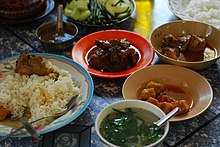
InBurmese cuisine,curries are broadly calledhin.Burmese curriesgenerally consist of protein that is simmered in a curry base of aromatics including shallots, onions, ginger, and garlic, alongside dried spices like turmeric, paprika, and garam masala. Burmese curries generally differ from other Southeast Asian curries in that dried spices are also used commonly to season the dishes, while coconut milk is only used sparingly for select dishes.
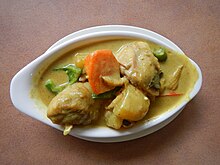
In the Philippines,two kinds of curry traditions are seen corresponding with the cultural divide between the Hispanicised north and Indianised/Islamised south. In the northern areas, a linear range of new curry recipes could be seen. The most common is a variant of the nativeginataang manok(chicken cooked in coconut milk) dish with the addition ofcurry powder,known as the "Filipino chicken curry".This is the usual curry dish that northern Filipinos are familiar with. Similarly, other northern Filipino dishes that can be considered" curries "are usuallyginataan(cooked with coconut milk) variants of other native meat or seafood dishes such asadobo,kaldereta,andmechado,that simply add curry powder or non-native Indian spices.[43]

InThai cuisine, curriesare calledkaeng,and usually consist of meat, fish or vegetables in a sauce based on a paste made from chilies, onions or shallots, garlic, andshrimp paste.[44]Additional spices and herbs define the type of curry. Local ingredients, such as chili peppers,kaffir limeleaves,lemongrass,galangalare used and, in central and southern Thai cuisine, coconut milk. Northern and northeastern Thai curries generally do not contain coconut milk. Due to the use of sugar and coconut milk, Thai curries tend to be sweeter than Indian curries. In the West, some of the Thai curries are described by colour;red curriesuse red chilies whilegreen curriesuse green chilies.Yellow curry—calledkaeng kari(by various spellings) inThai,of which a literal translation could be "curry soup" —is more similar to Indian curries, with the use of turmeric, cumin, and other dried spices. A few stir-fried Thai dishes also use an Indian style curry powder (Thai:phong kari).

InVietnamese cuisine,it is known ascà riand is made of ingredients such as coconut milk, potatoes, sweet potatoes, taro, and chicken, along with coriander and green onions. This dish is more like soup than Indian curry. Goat meat curry is also available, but only in a few special restaurants in Vietnam. Curry is often served with bread, vermicelli or rice. Curry is considered a dish in the south. The other ingredients of the curry are very diverse, depending on the meat ingredients, the main fruit for cooking curry as well as the chef's creativity. Vietnamese curries are also made with coconut milk, red cashew, onions, ginger, potatoes, sweet potatoes, carrots, radishes, vegetables, and various types of meat.[citation needed]
Africa[edit]

Consumption of curry spread toSouth Africawith the migration of people from the Indian subcontinent to the region in the colonial era.Africancurries,Cape Malaycurries andNatalcurries include the traditional Natal curry, the Durban curry,Bunny chow,and roti rolls. South African curries appear to have been founded in bothKwaZulu-Nataland theWestern Cape,while other curries developed across the country over the late 20th century and early 21st century to include ekasi, coloured, andAfrikanercurries.[45]Durbanhas the largest population of Indians outside of India in the world.[46]Bunny chow or a "set", a South African standard, consists of either lamb, chicken or bean curry poured into a tunnelled-out loaf of bread to be eaten with one's fingers by dipping pieces of the bread into it.[45][46]
Europe[edit]

Curry is very popular in theUnited Kingdom,with a curry house in nearly every town.[47][48]Such is the popularity of curry in the United Kingdom, that it has frequently been called its "adopted national dish".[49]It was estimated that in 2016 there were 12,000 curry houses, employing 100,000 people and with annual combined sales of approximately £4.2 billion.[50]
The food offered is Indian food cooked to British taste, but with increasing demand for authentic Indian styles. As of 2015, curry houses accounted for a fifth of the restaurant business in the UK, but, being historically a low wage sector, they were plagued by a shortage of labour. Established Indian immigrants from South Asia were moving on to other occupations; there were difficulties in training Europeans to cook curry; and immigration restrictions, which require payment of a high wage to skilled immigrants, had crimped the supply of new cooks.[51]
Curry powder[edit]
"Curry powder", as available in certain western markets, is a commercial spice blend, and first sold by Indian merchants to European colonial traders. This resulted in the export of a derived version of Indian concoction of spices.[52]and commercially available from the late 18th century,[53][54]with brands such asCrosse & BlackwellandSharwood'spersisting to the present.[55]British traders introduced the powder to Meiji Japan, in the mid-19th century, where it became known asJapanese curry.[56]
See also[edit]
Gallery[edit]
-
Abalti lambcurry
-
Butter chickenserved in an Indian restaurant
-
Buttermilk curryfrom Kerala
-
Curry chickenfrom Pakistan
-
Homemadechicken tikka masala
-
Karnataka food
-
Korean curry rice
-
Mango curry from Kerala
-
Nihariwith nihari salad
-
Porkvindalooin a Goan restaurant
-
Red roastduck curry (hot and spicy) from Thailand
-
Rice andChenopodium albumleaf curry with onions and potatoes; a vegetarian curry
-
Rogan joshcurry
-
Yoghurt andgram flourcurry
-
Anda (egg) curry
References[edit]
- ^"Curry".Encyclopædia Britannica.Archivedfrom the original on 13 August 2021.Retrieved25 August2021.
- ^"Definition of Curry".Merriam-Webster.Archivedfrom the original on 10 August 2021.Retrieved25 August2021.
- ^"Fresh Curry Leaves Add a Touch of India".NPR. 28 September 2011.Archivedfrom the original on 11 April 2018.Retrieved6 April2018.
- ^"Curry definition and synonyms".Macmillan Dictionary.Archived fromthe originalon 12 June 2018.Retrieved13 December2016.
- ^Raghavan, S. (2007).Handbook of Spices, Seasonings and Flavourings.CRC Press. p. 302.ISBN978-0-8493-2842-8.
- ^abVan Esterik, Penny (2008).Food Culture in Southeast Asia.ABC-CLIO. pp. 58–59.ISBN9780313344206.
- ^abCollingham, Lizzie (2006).Curry: A Tale of Cooks and Conquerors.New York, NY: Oxford University Press. p.115.Archivedfrom the original on 16 April 2020.Retrieved16 July2020.
No Indian, however, would have referred to his or her food as a curry. The idea of curry as a particular dish does not exist in India. Indians referred to their different dishes by specific names. But the British lumped all these together under the heading of curry
- ^Senthil Kumar, A. S. (2017).An Etymological Dictionary of Tamil Loanwords in English, Hindi, Sanskrit, Greek, Minoan, and Cypro-Minoan Languages.Senthil Kumar A.S. p. 83.Archivedfrom the original on 19 February 2023.Retrieved23 January2020.
- ^ab"Curry".Online Etymology Dictionary, Douglas Harper. 2018.Archivedfrom the original on 9 October 2018.Retrieved8 October2018.
- ^"curry, n.²",Oxford English Dictionary(3 ed.), Oxford University Press, 6 February 2024,doi:10.1093/oed/9671826565,retrieved31 March2024
- ^"What we know as" curry "has a long and curious history".The Takeout.28 February 2018.Retrieved31 March2024.
- ^"kari – A Dravidian Etymological Dictionary".Archivedfrom the original on 23 June 2020.
- ^abcTaylor, Anna-Louise (11 October 2013)."Curry: Where did it come from?".BBC Food.Archived fromthe originalon 29 March 2014.Retrieved4 January2017.
- ^abSahni, Julie (1980).Classic Indian Cooking.New York: William Morrow. pp. 39–40.
- ^"Thys fourme of cury ys compyled of þe mayster cokes of kyng Richard þe secund... by assent of Maysters of physik and of phylosophye".Things sweet to taste: selections from the Forme of Cury.1996ISBN0-86373-134-1
- ^Manguin, Pierre-Yves (2016)."Austronesian Shipping in the Indian Ocean: From Outrigger Boats to Trading Ships".In Campbell, Gwyn (ed.).Early Exchange between Africa and the Wider Indian Ocean World.Palgrave Macmillan. pp. 51–76.ISBN9783319338224.Archivedfrom the original on 26 March 2023.Retrieved26 March2023.
- ^Solheim, Wilhelm G.(1996). "The Nusantao and north-south dispersals".Bulletin of the Indo-Pacific Prehistory Association.15:101–109.
- ^Manguin, Pierre-Yves (2016)."Austronesian Shipping in the Indian Ocean: From Outrigger Boats to Trading Ships".In Campbell, Gwyn (ed.).Early Exchange between Africa and the Wider Indian Ocean World.Palgrave Macmillan. pp. 51–76.ISBN9783319338224.
- ^Iyer, Raghavan (2008).660 Curries.New York: Workman Publishing. pp. 2–3.
- ^Davidson & Saberi 178
- ^"People Have Been Eating Curry for 4,500 Years".Smithsonian Magazine.Archivedfrom the original on 17 May 2021.Retrieved26 December2020.
- ^Lawler, Andrew (29 January 2013)."Where Did Curry Come From?".Slate.Archivedfrom the original on 15 November 2020.Retrieved27 December2020.
- ^Batsha, Nishant(25 June 2020)."Curry Before Columbus".Contingent.Archivedfrom the original on 17 May 2021.Retrieved15 December2020.
- ^"The Word Curry Came From a Colonial Misunderstanding".The Atlantic.20 April 2019.Archivedfrom the original on 17 May 2021.Retrieved10 May2021.
- ^Collingham, Lizzie (2005).Curry: A Biography.London: Chatto & Windus. p. 115.ISBN0701173351.
- ^"How Britain got the hots for curry".BBC. 26 November 2009.Archivedfrom the original on 28 January 2016.Retrieved29 January2016.
- ^Mishan, Ligaya (10 November 2017)."Asian-American Cuisine's Rise, and Triumph".The New York Times.ISSN0362-4331.Archivedfrom the original on 22 March 2023.Retrieved29 March2023.
- ^"Rogan Josh". In Khan Mohammed Sharief Waza, Khan Mohammed Shafi Waza, and Khan Mohammed Rafiq Waza (2007).Wazwaan: Traditional Kashmiri Cuisine.New Delhi: Roli & Janssen. p. 34.
- ^"Ghushtaba". In Khan Mohammed Sharief Waza, Khan Mohammed Shafi Waza, and Khan Mohammed Rafiq Waza (2007).Wazwaan: Traditional Kashmiri Cuisine.New Delhi: Roli & Janssen. p. 37.
- ^Audrey Gillan (20 June 2002)."From Bangladesh to Brick Lane".The Guardian.Archivedfrom the original on 26 August 2013.Retrieved4 November2015.
Some are even opening British-style curry restaurants with names like Taste of Bengal and the Last Days of the Raj.
- ^Nationalfoody."National Dish of Sri Lanka Rice and Curry".National Dishes of the World.Retrieved17 March2024.
- ^Colleen Taylor Sen (15 November 2009).Curry: A Global History.Reaktion Books. p. 105.ISBN978-1-86189-704-6.Archivedfrom the original on 26 December 2019.Retrieved16 July2020.
- ^Levitt, Alice (28 December 2016)."Our Latest Obsession: Portuguese Chicken at Wing Kee Restaurant".Houstonia.Archivedfrom the original on 7 March 2018.Retrieved6 March2018.
- ^S&B Company."History of Japanese curry".Archived fromthe originalon 11 April 2013.Retrieved28 February2013.
- ^Booth, Michael (2017).The Meaning of Rice: And Other Tales from the Belly of Japan.Random House. p. 278.ISBN9781473545816.Archivedfrom the original on 19 February 2023.Retrieved4 December2020.
- ^Itoh, Makiko (26 August 2011)."Curry – it's more 'Japanese' than you think".The Japan Times.ISSN0447-5763.Archivedfrom the original on 8 January 2018.Retrieved8 January2018.
- ^"The Curry Rice Research".Archived10 July 2011 at theWayback Machine(in Japanese)
- ^"[Best Brand] Ottogi becomes Korea's representative curry product".The Korea Herald.25 June 2015.Archivedfrom the original on 10 January 2017.Retrieved10 January2017.
- ^Sohn, JiAe (24 October 2014)."Ottogi Curry brings Indian cuisine to the table".Archivedfrom the original on 15 December 2018.Retrieved10 January2017.
- ^"5 Rekomendasi Lontong Kari Enak di Bandung, Cocok Pisan buat Sarapan!".idntimes(in Indonesian).Retrieved25 April2023.
- ^"Kare Rajungan Khas Tuban yang Gurih dan 'Nendang'".genpi.id(in Indonesian). 21 September 2021.Retrieved25 April2023.
- ^Hikayat Amir Hamzah 1 (Menentang Jin di Bukit Qaf).PTS Fortuna. 2008. p. 10.ISBN978-983-192-116-6.Archivedfrom the original on 19 February 2023.Retrieved5 January2016.
- ^"Pinoy Chicken Curry Recipe".Panlasang Pinoy.Archivedfrom the original on 20 April 2019.Retrieved20 April2019.
- ^"Thai cooking, food thai, Thai menu, pad thai recipe".The Nation.Thailand. Archived fromthe originalon 17 August 2016.Retrieved22 October2013.
- ^abSeid, Shelley (19 October 2017)."Curry is the story of South Africa on a plate".The Sunday Times.Archivedfrom the original on 27 January 2018.Retrieved27 January2018.
- ^abGovender-Ypma, Ishay (11 November 2017)."The Brutal History of South Africa's Most Famous Curry".Munchies.Archivedfrom the original on 28 January 2018.Retrieved27 January2018.
- ^Jahangir, Rumeana (26 November 2009)."How Britain got the hots for curry".BBC News.Archivedfrom the original on 24 August 2017.Retrieved14 October2018.
- ^"National Curry Week: Why Britain loves curry".Fleet Street Communications.13 October 2017.Archivedfrom the original on 10 January 2020.Retrieved16 July2020.
- ^Spinks, Rosie (8 July 2005)."Curry on cooking: how long will the UK's adopted national dish survive?".The Guardian.Archivedfrom the original on 7 July 2018.Retrieved14 October2018.
- ^Moore, Malcolm (8 January 2016)."The great British curry crisis".Financial Times.Archivedfrom the original on 14 October 2018.Retrieved14 October2018.
- ^Kimiko de Freytas-Tamura (4 November 2015)."Britons Perturbed by a Troubling Shortage of Curry Chefs".The New York Times.Archivedfrom the original on 7 November 2015.Retrieved4 November2015.
- ^"Monks discover chicken curry recipe in 200-year-old cookbook".The Telegraph.13 January 2016.Archivedfrom the original on 11 January 2022.
- ^"First British advert for curry powder".bl.uk.Archivedfrom the original on 23 August 2021.Retrieved29 December2020.
- ^Nupur Chaudhuri; Margaret Strobel (1992).Western Women and Imperialism: Complicity and Resistance.Indiana University Press. pp. 240–.ISBN0-253-20705-3.Archivedfrom the original on 13 April 2023.Retrieved29 December2020.
- ^"TV review: Inside the Factory lifts the lid on how our curries are made".The Independent.15 August 2018.Archivedfrom the original on 17 October 2021.Retrieved7 March2021.
- ^Itoh, Makiko (26 August 2011)."Curry — it's more 'Japanese' than you think".The Japan Times.Archived fromthe originalon 8 January 2018.Retrieved19 May2019.
Further reading[edit]
- Chapman, Pat.Curry Club Indian Restaurant Cookbook.London – Piatkus.ISBN0-86188-378-0&ISBN0-86188-488-4(1984 to 2009)
- Chapman, Pat.The Little Curry Book.London – Piatkus.ISBN978-0861883646(1985)
- Achaya, K.T.A Historical Dictionary of Indian Food.Delhi,Oxford University Press(1998)
- Grove, Peter & Colleen.The Flavours of History.London, Godiva Books (2011)
- Chapman, Pat.India: Food & Cooking.London, New Holland –ISBN978-1-84537-619-2(2007)
- Indian Food: A Historical Companion.Delhi, Oxford University Press, 1994
- David Burton.The Raj at Table.London,Faber and Faber(1993)
- Pat Chapman's Curry Bible.Hodder & St –ISBN0-340-68037-7&ISBN0-340-68037-7&ISBN0-340-68562-X&ISBN0-340-68562-X(1997)
- New Curry Bible,An unaltered edition ofPat Chapman's Curry Biblepublished by John Blake Publishers.ISBN978-1-84358-159-8(2005)
- E.M. Collingham.Curry: A Biography.London,Chatto & Windus,2005
- An Invitation to Indian Cooking.London, Penguin, 1975
- Jaffrey, Madhur.Various books on curry from 1973 to 2015.
- Chapman, Pat.Petit Plats Curry.Paris. Hachette Marabout.ISBN2-501-03308-6(2000)
- Afghan cuisine
- Belizean cuisine
- Bengali cuisine
- Bangladeshi cuisine
- Bhutanese cuisine
- British cuisine
- Burmese cuisine
- Chili pepper dishes
- Chinese cuisine
- Fi gian cuisine
- Guyanese cuisine
- Indian cuisine
- Indo-Caribbean cuisine
- Indonesian cuisine
- Jamaican cuisine
- Japanese cuisine
- Kashmiri cuisine
- Korean cuisine
- Malaysian cuisine
- Maldivian cuisine
- Mauritian cuisine
- Nepalese cuisine
- Omani cuisine
- Pakistani cuisine
- Filipino cuisine
- Saint Helenian cuisine
- Seychellois cuisine
- Somali cuisine
- South African cuisine
- South Asian cuisine
- Sri Lankan cuisine
- Thai cuisine
- Vietnamese cuisine

